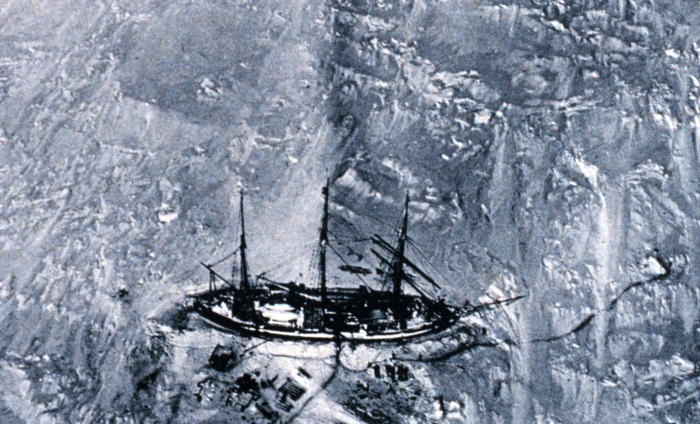Gauss (ship) on:
[Wikipedia]
[Google]
[Amazon]
''Gauss'' was a ship built in Germany specially for polar exploration, named after the
 The ship was built by the
The ship was built by the
 Between 1901 and 1903 ''Gauss'' explored the
Between 1901 and 1903 ''Gauss'' explored the
W.B. Wiegand Diary of a Voyage on the Arctic in 1912
at Dartmouth College Library {{DEFAULTSORT:Gauss 1901 ships Exploration ships Canadian Government Ship
mathematician
A mathematician is someone who uses an extensive knowledge of mathematics in their work, typically to solve mathematical problems.
Mathematicians are concerned with numbers, data, quantity, structure, space, models, and change.
History
On ...
and physical scientist Carl Friedrich Gauss. Purchased by Canada in 1904, the vessel was renamed CGS ''Arctic''. As ''Arctic'', the vessel made annual trips to the Canadian Arctic until 1925. The ship's fate is disputed among the sources, but all claim that by the mid-1920s, the vessel was out of service.
Ship construction
 The ship was built by the
The ship was built by the Howaldtswerke-Deutsche Werft
Howaldtswerke-Deutsche Werft (often abbreviated HDW) is a German shipbuilding company, headquartered in Kiel. It is part of the ThyssenKrupp Marine Systems (TKMS) group, owned by ThyssenKrupp. The Howaldtswerke shipyard was founded in Kiel in 183 ...
shipyard at Kiel
Kiel () is the capital and most populous city in the northern Germany, German state of Schleswig-Holstein, with a population of 246,243 (2021).
Kiel lies approximately north of Hamburg. Due to its geographic location in the southeast of the J ...
at a cost of 500,000 marks. Launched on 2 April 1901 she was modelled on Fridtjof Nansen
Fridtjof Wedel-Jarlsberg Nansen (; 10 October 186113 May 1930) was a Norwegian polymath and Nobel Peace Prize laureate. He gained prominence at various points in his life as an explorer, scientist, diplomat, and humanitarian. He led the team t ...
's ship ''Fram
Fram may refer to:
Ships
* ''Fram'' (ship), an arctic exploration vessel from Norway
* MS ''Fram'', expedition cruise ship owned by Hurtigruten Group
Places and geography
* Fram, Paraguay, a town in Itapúa, Paraguay
* Fram Formation, a se ...
'', and rigged as a barquentine
A barquentine or schooner barque (alternatively "barkentine" or "schooner bark") is a sailing vessel with three or more masts; with a square rigged foremast and fore-and-aft rigged main, mizzen and any other masts.
Modern barquentine sailing r ...
. Displacing , ''Gauss'' had a tonnage of . The ship was long, in the beam
Beam may refer to:
Streams of particles or energy
*Light beam, or beam of light, a directional projection of light energy
**Laser beam
*Particle beam, a stream of charged or neutral particles
**Charged particle beam, a spatially localized grou ...
, with a draught of . With a triple expansion steam engine
A compound steam engine unit is a type of steam engine where steam is expanded in two or more stages.
A typical arrangement for a compound engine is that the steam is first expanded in a high-pressure ''(HP)'' cylinder, then having given up he ...
driving one screw
A screw and a bolt (see '' Differentiation between bolt and screw'' below) are similar types of fastener typically made of metal and characterized by a helical ridge, called a ''male thread'' (external thread). Screws and bolts are used to fa ...
to augment the sails, she was capable of .
Classed "A1" by Germanischer Lloyd
The Germanischer Lloyd SE was a classification society based in the city of Hamburg, Germany. It ceased to exist as an independent entity in September 2013 as a result of its merger with Norway's DNV (Det Norske Veritas) to become DNV GL.
Before ...
s, she was designed to carry 700 tons of stores, enough to make her self-sufficient for up to three years with a crew of 30 aboard. The hull was exceptionally strong, and the rudder and propeller were designed to be hoisted aboard for inspection or repairs.
Ship history
 Between 1901 and 1903 ''Gauss'' explored the
Between 1901 and 1903 ''Gauss'' explored the Antarctic
The Antarctic ( or , American English also or ; commonly ) is a polar region around Earth's South Pole, opposite the Arctic region around the North Pole. The Antarctic comprises the continent of Antarctica, the Kerguelen Plateau and other ...
in the Gauss expedition
The ''Gauss'' expedition of 1901–1903 (also known as the ''Deutsche Südpolar-Expedition 1901–1903)'' was the first German expedition to Antarctica. It was led by geologist Erich von Drygalski in the ship , named after the mathematician and p ...
under the leadership of Erich von Drygalski
Erich Dagobert von Drygalski (; February 9, 1865 – January 10, 1949) was a German geographer, geophysicist and polar scientist, born in Königsberg, East Prussia.
Between 1882 and 1887, Drygalski studied mathematics and natural science at t ...
.
In early 1904 the ship was purchased by the Canadian government under the advice of Joseph-Elzéar Bernier, who had surveyed the ship before the acquisition. The ship was renamed ''Arctic'' and under the command of Bernier she explored the Arctic Archipelago
The Arctic Archipelago, also known as the Canadian Arctic Archipelago, is an archipelago lying to the north of the Canadian continental mainland, excluding Greenland (an autonomous territory of Denmark).
Situated in the northern extremity of No ...
. Bernier and ''Arctic'' made annual expeditions to Canada's north. On 1 July 1909, Bernier, without government approval, claimed the entire area between Canada's eastern and western borders all the way to the North Pole
The North Pole, also known as the Geographic North Pole or Terrestrial North Pole, is the point in the Northern Hemisphere where the Earth's axis of rotation meets its surface. It is called the True North Pole to distinguish from the Mag ...
. Bernier only left the ship during the First World War
World War I (28 July 1914 11 November 1918), often abbreviated as WWI, was one of the deadliest global conflicts in history. Belligerents included much of Europe, the Russian Empire, the United States, and the Ottoman Empire, with fightin ...
, returning to command ''Arctic'' again from 1922 to 1925. The vessel's end is not agreed upon. According to ''schiffe-und-mehr.com'', ''Arctic'' was abandoned in 1925 and left to rot at her moorings. Maginley and Collin claim the vessel was broken up in 1926 while the Miramar Ship Index say the ship was abandoned in 1927.
See also
*List of Antarctic exploration ships from the Heroic Age, 1897–1922
This list includes all the main Antarctic exploration ships that were employed in the seventeen expeditions that took place in the era between 1897 and 1922, known as the Heroic Age of Antarctic Exploration. A subsidiary list gives details of su ...
Notes
References
Further reading
*External links
W.B. Wiegand Diary of a Voyage on the Arctic in 1912
at Dartmouth College Library {{DEFAULTSORT:Gauss 1901 ships Exploration ships Canadian Government Ship